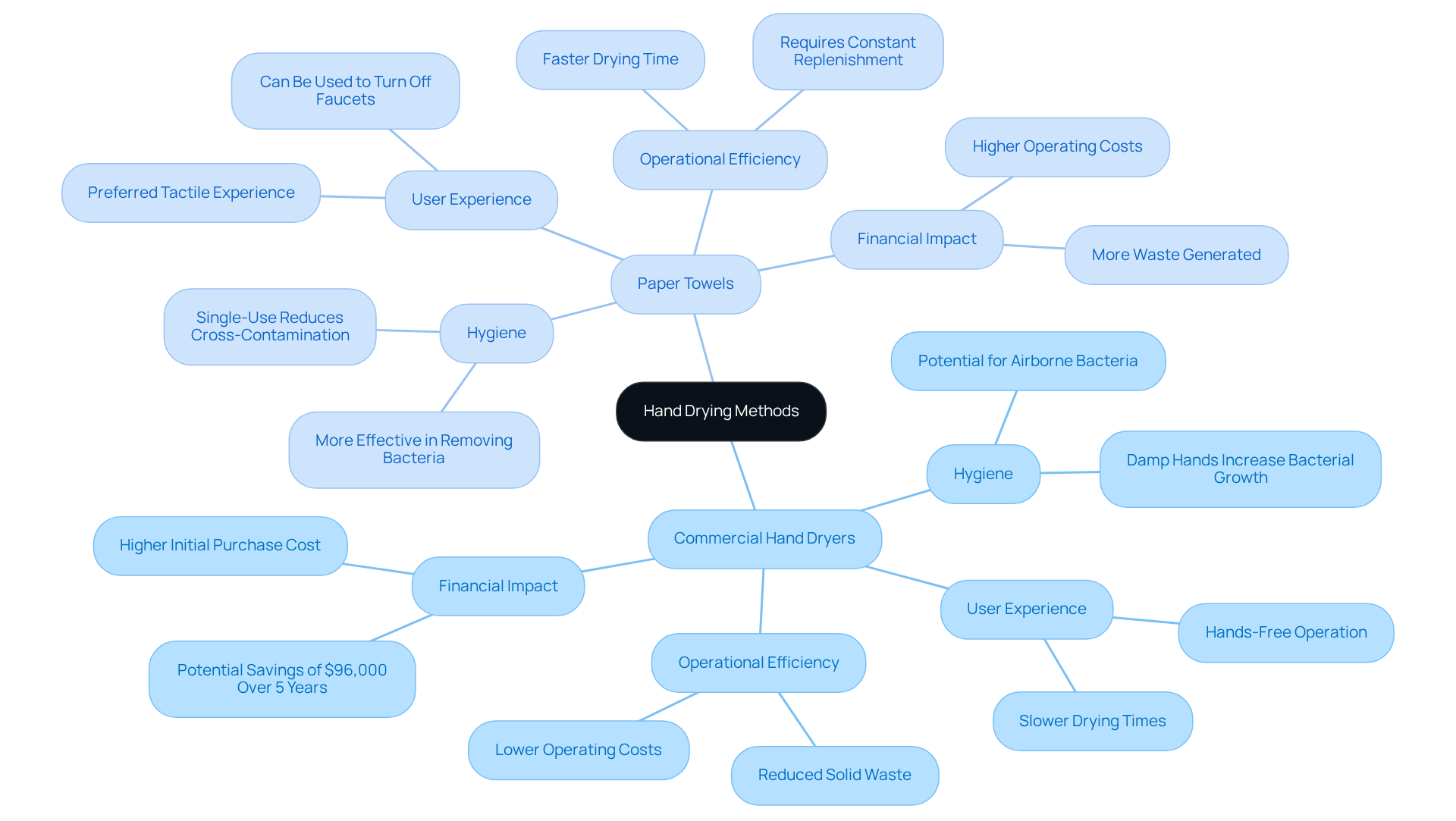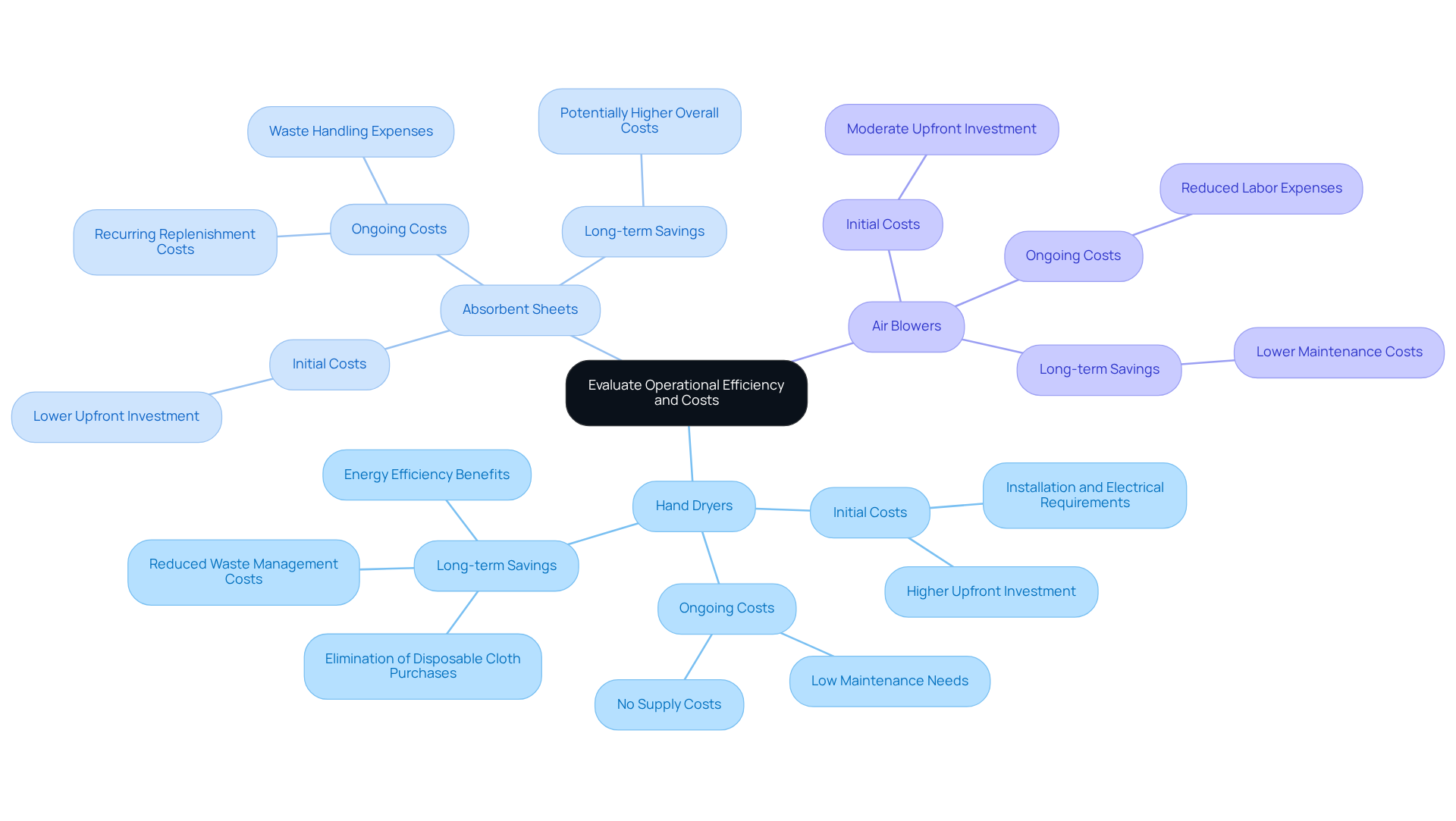Overview
This article provides a comprehensive comparison of commercial hand dryers and paper towels, focusing on their respective advantages and disadvantages for architects involved in restroom design. It asserts that while hand dryers deliver efficiency and long-term cost savings, paper towels are often regarded as more hygienic. This perception stems from their ability to effectively remove bacteria and offer a tactile experience. Consequently, architects must engage in a careful evaluation of hygiene, operational costs, and environmental impact when making design decisions.
Introduction
Commercial hand dryers and paper towels are pivotal in restroom hygiene and user experience. However, their effectiveness and environmental impact often ignite debate among architects and facility designers. This article explores the critical comparisons between these two drying methods, emphasizing their:
- Operational efficiency
- Cost implications
- Aesthetic integration within contemporary restroom designs
As architects navigate the intricate balance of restroom functionality and sustainability, the pressing question remains: which option truly achieves the optimal harmony of hygiene, cost-effectiveness, and design appeal in today’s commercial spaces?
Compare Commercial Hand Dryers and Paper Towels
Commercial hand dryers and paper towels serve a fundamental purpose: drying palms after washing. Commercial hand dryers, available in warm air or jet air types, provide a hands-free option that minimizes contact with surfaces, thereby enhancing hygiene. Typically, they operate more quickly and can handle high traffic volumes without the need for constant replenishment.
However, commercial hand dryers may leave fingers damp, increasing susceptibility to bacterial growth, which raises hygiene concerns. Conversely, absorbent sheets provide a tactile experience that many users prefer, as they can be used to turn off faucets and open doors, further reducing contact with potentially contaminated surfaces.
Research indicates that paper towels are perceived as more effective in mitigating the transmission of germs in public restrooms, as they physically remove bacteria from fingers without generating airborne germs, a concern associated with certain commercial hand dryers. For instance, studies have shown that commercial hand dryers can disperse bacteria up to three feet, exacerbating hygiene issues in settings such as healthcare facilities.
Recognizing these fundamental distinctions is essential for architects when designing restroom environments that prioritize user experience and operational efficiency. Furthermore, a financial analysis by Duke University suggests that transitioning to commercial hand dryers could yield potential savings of up to $96,000 over five years, making them a financially viable option.
As underscored in several architectural case studies, including those related to The Splash Lab's tailored restroom solutions for Lacuna Space and Padel Haus, the integration of efficient drying techniques is vital for enhancing the overall restroom experience.

Evaluate Operational Efficiency and Costs
When evaluating operational efficiency, it is essential to consider the upfront costs associated with hand dryers, which are generally higher due to installation and electrical requirements. However, commercial hand dryers often lead to significant long-term savings by eliminating the need for ongoing disposable cloth purchases and waste management services. In contrast, absorbent sheets may require a smaller initial investment, yet they can incur substantial recurring costs for replenishment and waste handling. Furthermore, air blowers can reduce labor expenses related to upkeep and supply restocking. Therefore, architects must carefully assess the specific usage patterns of the restroom to determine which option strikes the optimal balance between initial investment and ongoing operational costs.

Assess Environmental Sustainability and Waste Management
From an ecological perspective, commercial hand dryers represent a more sustainable choice compared to disposable towels. They significantly reduce waste associated with paper products and mitigate the environmental impacts linked to the production and disposal of commercial hand dryers.
Modern commercial hand dryers are designed for energy efficiency, often consuming less electricity than older models. Conversely, disposable cloths contribute to substantial waste, with millions of tons discarded in landfills each year. The manufacturing process for absorbent sheets not only involves deforestation but also requires considerable water resources, leading to serious sustainability concerns.
Furthermore, tissue dispensers necessitate more frequent maintenance, including regular refilling, which results in operational inefficiencies. Notably, using two standard absorbent sheets generates approximately 0.123 pounds of greenhouse gas, a figure five times greater than that produced by an air blower.
Architects must carefully evaluate these factors when selecting drying solutions, particularly the higher initial cost of electric units compared to paper towel dispensers. In addition, commercial hand dryers eliminate the need for replenishing supplies and managing waste, which helps keep washrooms clean and organized.
With a lifespan of 7 to 10 years, these devices also reduce the frequency of replacements, further enhancing their sustainability. By prioritizing sustainable restroom designs, architects can improve both functionality and ecological responsibility in commercial spaces that incorporate commercial hand dryers.

Examine Aesthetic Appeal and Design Integration
Aesthetic appeal is paramount in restroom design, significantly influencing user perceptions and experiences. Hand devices from The Splash Lab are available in a diverse array of designs and finishes, enabling architects to seamlessly integrate them into modern restroom environments. Their wall-mounted installation not only conserves space but also contributes to a clean and uncluttered aesthetic. Research indicates that 75% of users prefer the appearance of commercial hand dryers over cloth dispensers, underscoring their importance in restroom design. Conversely, paper towel dispensers can vary widely in design; if not chosen with care, they risk disrupting the visual harmony of the restroom.
As Brent Otsuka, Manager of Interior Design at Fentress Architects, observes, 'The key to breaking this image is to design a toilet that meets essential requirements, including aesthetics.' This perspective aligns with The Splash Lab's dedication to quality craftsmanship and comprehensive restroom solutions. Consequently, architects must meticulously consider the overall design theme and user experience when selecting commercial hand dryers, ensuring these fixtures enhance the restroom's aesthetic rather than detract from it.
Case studies, such as the Lacuna Space and Padel Haus projects, illustrate how thoughtfully designed commercial hand dryers from The Splash Lab can enhance the restroom experience while adhering to contemporary design trends.
Conclusion
Choosing between commercial hand dryers and paper towels is a critical decision for architects, significantly impacting hygiene, operational efficiency, and environmental sustainability. Hand dryers present a hands-free, low-maintenance solution that reduces waste, while paper towels offer a tactile experience that many users prefer. Understanding the strengths and weaknesses of each option is essential for creating restroom environments that prioritize user experience and operational efficiency.
The article highlights several key points:
- Hand dryers can minimize contact with surfaces and reduce long-term costs; however, they may not dry hands completely, raising hygiene concerns.
- Conversely, paper towels effectively remove bacteria but incur ongoing costs and waste management challenges.
- Furthermore, the aesthetic appeal of hand dryers can enhance restroom design, aligning with contemporary architectural trends while promoting sustainability.
In light of these considerations, architects are encouraged to evaluate their specific restroom usage patterns and design goals. By carefully weighing the operational costs, environmental impacts, and user preferences, a more informed choice can be made that not only meets the practical needs of the space but also contributes to a more sustainable future. The integration of efficient drying solutions is not merely a matter of functionality; it is a vital aspect of designing modern, user-centered restroom environments.
Frequently Asked Questions
What is the primary function of commercial hand dryers and paper towels?
The primary function of both commercial hand dryers and paper towels is to dry palms after washing.
What are the types of commercial hand dryers available?
Commercial hand dryers are available in two types: warm air and jet air.
What are the hygiene benefits of using commercial hand dryers?
Commercial hand dryers provide a hands-free option that minimizes contact with surfaces, thereby enhancing hygiene.
What are the potential hygiene concerns associated with commercial hand dryers?
Commercial hand dryers may leave fingers damp, which can increase susceptibility to bacterial growth. Additionally, they can disperse bacteria into the air, potentially exacerbating hygiene issues.
How do paper towels compare to hand dryers in terms of germ transmission?
Research indicates that paper towels are perceived as more effective in mitigating the transmission of germs, as they physically remove bacteria from fingers without generating airborne germs.
What evidence suggests that commercial hand dryers can spread bacteria?
Studies have shown that commercial hand dryers can disperse bacteria up to three feet, raising concerns particularly in sensitive environments like healthcare facilities.
Why is it important for architects to recognize the distinctions between hand dryers and paper towels?
Recognizing these distinctions is essential for architects when designing restroom environments that prioritize user experience and operational efficiency.
What financial benefits might come from transitioning to commercial hand dryers?
A financial analysis by Duke University suggests that transitioning to commercial hand dryers could yield potential savings of up to $96,000 over five years.
Can you provide examples of architectural case studies related to restroom solutions?
Several architectural case studies, such as those from The Splash Lab for Lacuna Space and Padel Haus, underscore the importance of integrating efficient drying techniques to enhance the overall restroom experience.




